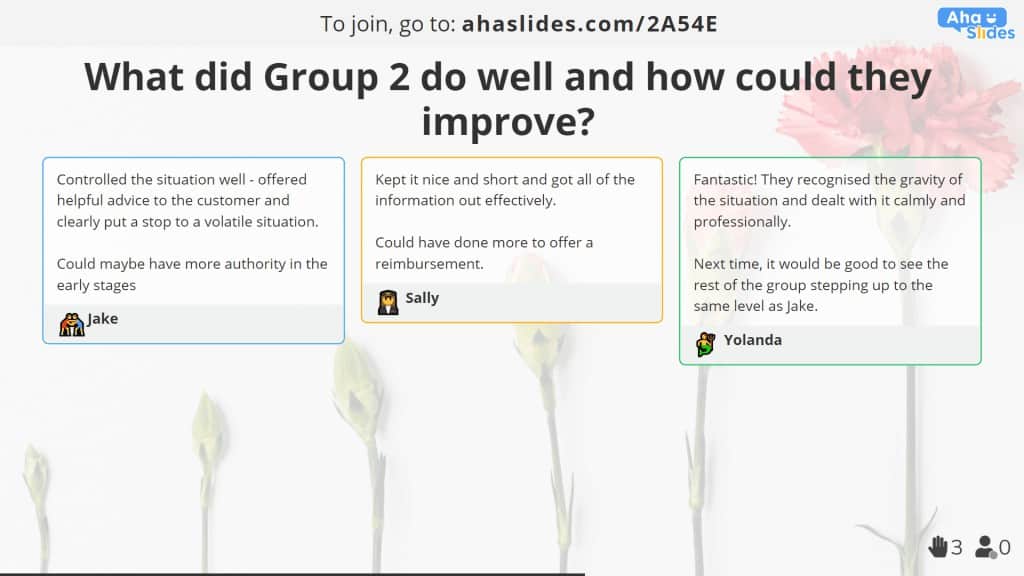A study by the Association for Talent Development found that employees who receive formal on-the-job training programs are 2.5 times more likely to feel empowered to do their jobs than those who do not receive such training.
With many advantages, more and more companies adapt their on-the-job training programs with new teaching and training methods as well as technology to ensure the efficacy of the training and look for more talents.
In this article, you'll learn more about On-the-job training programs and why they are identified as one of the top ways to address skills gaps in the workforce and increase in employee retention.

Table of Contents
- What is the meaning of on-the-job training programs?
- What is the purpose of on-the-job training programs?
- What are the 6 types of on-the-job training programs?
- What are examples of on-the-job training programs?
- Tips to build an On-the-job training programs
- Key Takeaways
Tips for Better Engagement
- How to train your staff effectively
- Ultimate Training and Development in HRM | Everything You Need to Know in 2025
- Expanding Your Professional Network with The 11 Best Strategies in 2025
- Personalized training plan

Looking for Ways to Train your Team?
Gather your team members by a fun quiz on AhaSlides. Sign up to take free quiz from AhaSlides template library!
🚀 Grab Free Quiz☁️
What is the Meaning of On-The-Job Training Programs?
On-the-job training programs refer to a type of training that takes place in a real work setting or environment rather than in a classroom or training facility.
This type of training allows employees to learn the necessary skills and knowledge for their job while performing their actual work duties under the supervision of a more experienced coworker or trainer.
Additionally, On-the-job training programs are also often used to introduce new employees to a company's policies, procedures, and culture, as well as to provide ongoing training and development opportunities to existing employees.

What is the Purpose of On-The-Job Training Programs?
As mentioned before, the purpose of on-the-job training programs is to provide employees with the knowledge, skills, and experience they need to perform their jobs effectively.
This training is typically hands-on and allows employees to learn by doing rather than simply listening to lectures or reading manuals.
Some of the benefits of on-the-job training programs include:
- Increased productivity: When employees receive proper training, they are better equipped to perform their job responsibilities and can work more efficiently.
- Reduced errors and mistakes: Proper training can help employees understand how to perform tasks correctly and avoid costly errors.
- Improved job satisfaction: When employees feel confident in their ability to perform their job responsibilities, they are more likely to be satisfied with their work.
- Higher retention rates: Employees who receive training and development opportunities are more likely to stay with their employer and be more committed to their work.

What are the 6 Types of On-The-Job Training Programs?
Apprenticeship
An apprenticeship is a type of on-the-job training program that requires classroom instruction. It is designed to provide individuals with the skills and knowledge they need to succeed in a particular trade or profession.
During apprenticeship on-the-job training programs, individuals work under the guidance of an experienced professional, known as a mentor or a journeyman. They learn the practical skills of the trade or profession by performing hands-on work and observing the mentor's techniques. They also receive classroom instruction, typically through a vocational school or community college, which covers the theoretical knowledge and principles behind the work.
Apprenticeships can vary in length depending on the trade or profession, but they generally last from one to five years. At the end of the program, apprentices are often required to pass a certification exam to demonstrate their competence in the field.

Job instruction
Another popular on-the-job training program, Job instruction, aims to teach employees how to perform specific tasks or job duties. It involves breaking down a job into a series of steps and then teaching those steps to the employee in a structured and organized manner.
The four steps of job instruction are:
- Preparation: The trainer reviews the job, breaks it down into its component parts and prepares an outline of the steps to be taught.
- Presentation: The trainer presents the job instructions to the employee, explaining each step in detail and demonstrating how to perform the task.
- Performance: The employee practices the task under the guidance of the trainer, with feedback and correction as needed.
- Follow-up: The trainer checks the employee's work and provides additional coaching or instruction as necessary to ensure that the employee has mastered the task.
Job Rotation
If your on-the-job training programs focus on developing a strategy in which employees are moved through different jobs within the organization for a set period of time, it should be Job Rotation. This approach helps employees gain exposure to different functions, departments, and job responsibilities and helps them develop a broader set of skills and knowledge.
Job rotation can take many different forms, from short-term assignments within a single department to longer-term assignments in different business units or geographic locations. It is typically structured and planned in advance, with specific goals and objectives for each rotation.
Understudy
An understudy is a person who is trained to take over the duties and responsibilities of another employee in the event that the employee is absent or unable to perform their job. Understudies are commonly used in theater productions on-the-job training programs, where an actor or actress may have an understudy who can step in if they are unable to perform due to illness or other reasons.
In a workplace setting, this type of job training is often used in key positions where the absence of the primary employee could have significant consequences for the organization. For example, a CEO may have an understudy who is trained to step in if the CEO is temporarily unavailable.
Coaching and Mentoring
While coaching and mentoring share some similarities, there are some key differences between the two approaches. Coaching is typically focused on specific tasks or skills, while mentoring is focused on broader career development goals. Coaching is often a shorter-term engagement, while mentoring relationships may last for several years.
Coaching is a process of providing feedback, guidance, and support to an individual to help them improve their performance in a specific task or role. Mentoring, on the other hand, is a process of providing guidance and support to an individual to help them develop their career or personal goals.
Internships
The internship is a bit different compared to an Apprenticeship. An internship is a temporary work experience that is typically offered to students or recent graduates in order to provide them with practical, on-the-job training in a particular field or industry. Internships can be paid or unpaid and may last for a few weeks, months, or even a year.
Internships can be structured in a variety of ways, depending on the needs of the organization and the goals of the intern. Some internships may involve working on specific projects or tasks, while others may involve shadowing employees or attending meetings and events. In some cases, internships may lead to a job offer with the organization once their on-the-job training internship is complete.
What are Examples of On-The-Job Training Programs?
Hotel on-the-job training programs
The service industry, especially hotels and F&B, offers a range of on-the-job training programs, especially internship positions, every year, normally from 3 months to 1 year. In the first month, the trainee would shadow an experienced front desk trainer, observing their interactions with guests, how they handle check-ins and check-outs, and how they handle common guest inquiries.
Then, the trainee would be given opportunities to practice key tasks, such as checking in guests, making reservations, and answering phones. They might work with a supervisor or mid-senior receptionist to receive feedback and guidance on their performance.

On-the-job training program for teaching assistant
In on-the-job training teaching assistant programs, the trainee would be given arrangements to practice assisting in the classroom, such as helping students with assignments or supervising them during activities.
In addition, when the trainee shows their improvement during middle on-the-job training, they are likely to be trained to more complicated duties such as providing support to students who need extra help or attention, for example, students with special needs or those who are struggling with certain topics.
IT on-the-job training programs
Depending on the needs of the organization and the IT professional's role, they may receive specialized on-the-job training programs in different areas such as cybersecurity, network administration, or software development.
The IT professional would receive ongoing professional development opportunities to stay up-to-date with the latest technologies, best practices, and industry trends.
Tips to Build an On-the-job Training Programs
Building an effective on-the-job training program requires careful planning and execution. Here are some tips to help you create a successful program:
Identify learning objectives
At first, managers have to determine the skills and knowledge that employees need to acquire through the training program. This will help you create a more focused and effective training program.
Create a training plan
It is also important to develop a comprehensive plan that includes the goals, objectives, and timeline for the training program. This will help you stay on track and ensure that the training is completed within the allotted time.
Provide hands-on experience
On-the-job training is all about hands-on experience. Ensure that your training program provides ample opportunities for employees to practice what they have learned.
Assign mentors
Carefully assign mentors or trainers who can guide employees while training for a job, as not all seniors are good at coaching and mentoring. Mentors can help answer questions, provide feedback, and offer support throughout the training program.
Use real-world scenarios
Make sure that your company uses real-world scenarios to help trainees apply what they have learned in training to real-life situations. This will help reinforce the learning and ensure that employees are better equipped to handle on-the-job challenges.
Provide feedbacks
Most importantly, trainers have to provide regular feedback to employees on their progress and performance during the training program, which helps them stay motivated and engaged in the learning process.

Evaluate the program
Evaluating the effectiveness of the training program is also crucial to their improvement and development. It helps to identify areas of improvement and make necessary changes to ensure that the program meets the needs of both employees and the organization.
Gather surveys
Besides offering performance evaluations for trainees, it is important to ask them about their experience and opinions during the whole on-the-job training program. As different trainees will have different paces in learning and practising. Some even might encounter difficulties and are afraid to speak up.
AhaSlides survey template can be a great solution for your organization in terms of delivering live surveys and polls.

Adopt new technologies for on-the-job training programs
In the era of digital, it is beneficial to utilize new technology in your training, for example, using AhaSlides quiz and template to test trainees about what they have learned without giving them under too much pressure. Or using the AhaSlides brainstorming tool to help all trainees share an equal chance to show their opinions and creative ideas.
Key Takeaways
On-the-job training programs are a valuable investment in employee development that can pay off in many ways for both employees and employers. Though they are among the most effective ways to train employees, organizations still have to upgrade and advance their training frequently so that they are not outdated and more adaptive for the new generation.
Frequently Asked Questions:
Why the job training is important?
On-the-job training programs help employees obtain the skills needed for their jobs in a practical way so they can adapt quickly and perform better. By observing and learning from their coworkers, they can gradually become familiar with the tools and processes used in their jobs.
What is one of the main disadvantages of on-the-job training?
If the new staff doesn’t have the basic and required skills, this may be a drawback for the organization. In other words, it will take more time to train the employees, and the training cost will also increase.








